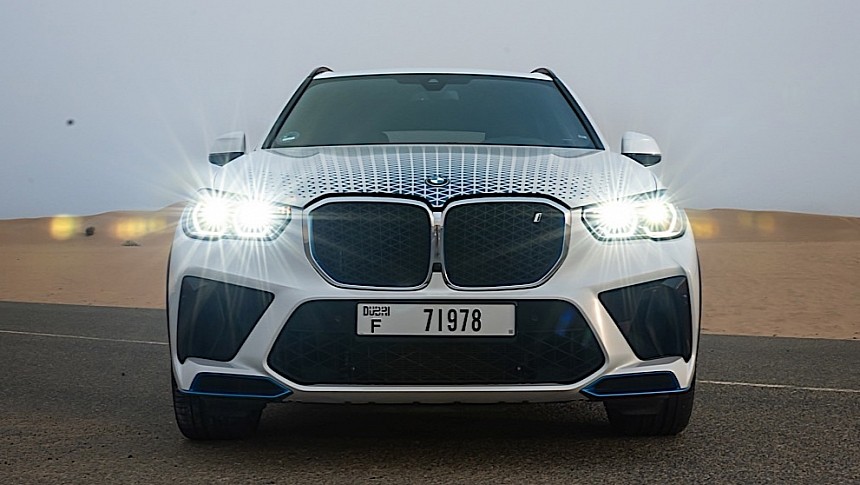Somewhere in the back of our minds, we all know there is a potentially better alternative to turning the automotive industry green than going for battery electric vehicles: hydrogen. Sadly, because developments on this front are very rare, that knowledge is buried so deep we barely notice it.
And then, in the span of a single week, we get word on hydrogen tech developments not from one, but two separate carmakers, and we feel hopeful again.
Earlier this week the Japanese from Toyota pulled the wraps of the hydrogen-powered Hilux, the prototype of a limited production run meant to test whether the system already deployed on the Mirai could work just as well on a pickup truck. It's unclear if Toyota will actually greenlight this alternative fuel Hilux for production, but it being here is reason to hope hydrogen is beginning to be taken a bit more seriously.
And now comes word from BMW, whose recently introduced iX5 Hydrogen fleet is conducting testing in several places around the globe, including Europe, Japan, Korea, China, the U.S., and the Middle East.
It's the SUV operating in the Middle East that's of concern to us today, as according to its maker it just wrapped up "an intensive round of hot-weather testing" for the first time. How hot? Well, up to 45 degrees Celsius (113 degrees Fahrenheit) hot, and made worse by the dust and varying humidity present in the United Arab Emirates desert.
As you probably know by now, the hydrogen system BMW fitted inside the modified X5 comprises a couple of hydrogen tanks made from carbon-fiber-reinforced plastic (with a combined capacity of around 6 kg/13 pounds of hydrogen), a battery, and an electric motor. All of them, the way they work with one another, and their interaction with the cooling system were tested under the scorching sun.
BMW does not go into the specifics of the tests and their findings, but by the looks of it the SUV and its alternative fuel system survived testing unscathed.
Work on the hydrogen system does not end here, with BMW set to continue testing for the foreseeable future. The carmaker is not only looking at ways to advance the tech, but it's also trying to help with the development of a hydrogen refueling network that would work for all hydrogen vehicles, regardless of make or size.
A production version of the BMW iX5 Hydrogen is being considered, but no actual decision to produce it for the masses has been taken yet.
If made and launched on the market in its current form, the iX5 will offer its drivers a total of 401 horsepower from the combined powers of the fuel system and eDrive. The total range the vehicle is capable of in this configuration is 504 km (313 miles) as per the WLTP cycle.
Earlier this week the Japanese from Toyota pulled the wraps of the hydrogen-powered Hilux, the prototype of a limited production run meant to test whether the system already deployed on the Mirai could work just as well on a pickup truck. It's unclear if Toyota will actually greenlight this alternative fuel Hilux for production, but it being here is reason to hope hydrogen is beginning to be taken a bit more seriously.
And now comes word from BMW, whose recently introduced iX5 Hydrogen fleet is conducting testing in several places around the globe, including Europe, Japan, Korea, China, the U.S., and the Middle East.
It's the SUV operating in the Middle East that's of concern to us today, as according to its maker it just wrapped up "an intensive round of hot-weather testing" for the first time. How hot? Well, up to 45 degrees Celsius (113 degrees Fahrenheit) hot, and made worse by the dust and varying humidity present in the United Arab Emirates desert.
As you probably know by now, the hydrogen system BMW fitted inside the modified X5 comprises a couple of hydrogen tanks made from carbon-fiber-reinforced plastic (with a combined capacity of around 6 kg/13 pounds of hydrogen), a battery, and an electric motor. All of them, the way they work with one another, and their interaction with the cooling system were tested under the scorching sun.
BMW does not go into the specifics of the tests and their findings, but by the looks of it the SUV and its alternative fuel system survived testing unscathed.
Work on the hydrogen system does not end here, with BMW set to continue testing for the foreseeable future. The carmaker is not only looking at ways to advance the tech, but it's also trying to help with the development of a hydrogen refueling network that would work for all hydrogen vehicles, regardless of make or size.
A production version of the BMW iX5 Hydrogen is being considered, but no actual decision to produce it for the masses has been taken yet.
If made and launched on the market in its current form, the iX5 will offer its drivers a total of 401 horsepower from the combined powers of the fuel system and eDrive. The total range the vehicle is capable of in this configuration is 504 km (313 miles) as per the WLTP cycle.













